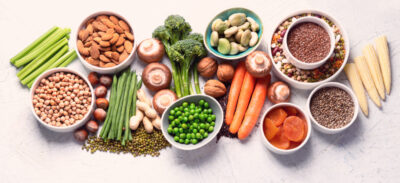
The iron intake in a plant diet
Iron is an essential micronutrient that helps with several bodily functions such as:
- Transporting oxygen throughout the body
- Ensuring proper immune system function
- Assisting with energy production in our cells
- Assisting in the development of myoglobin which in turn helps us store oxygen in our muscles
Iron deficiency is among the most common deficiencies in the world. Fortunately, it is also very easy to treat - most of the time an iron deficiency can be rectified simply by adding more iron to your diet.
The average human requires only a small amount of iron daily to maintain optimum levels. This can vary depending on your gender and age. However, our body does not absorb the full quantity of iron that we consume. This also varies depending on the individual’s capacity to absorb and store iron.
There are two types of iron - heme and non-heme iron. Heme iron is found in muscle tissue and hence in animal products. Non-heme iron is what is commonly available in a plant-based diet. The key difference between the two types is that heme iron is more easily absorbed by the body as opposed to non-heme iron. This is the reason why some vegans and vegetarians may have an iron deficiency despite eating a fair amount of iron-rich foods.
There are a few ways to make sure you’re getting enough iron on a plant-based diet.
The first step is to ensure that you are indeed eating enough iron-rich foods. Here are a few veggies that can help meet your daily iron requirement:
- Spinach: Spinach contains about 2.5mg of iron in every 100g. Additionally, spinach is also a good source of vitamin C. This helps our body absorb iron better. Spinach also has a multitude of other health benefits and is a great source of antioxidants.
- Lentils and beans: Lentils and beans are micronutrient powerhouses. 100g of legumes contain about 3g of iron. Additionally, they also have several other important vitamins and minerals like copper, potassium, manganese, folate, etc. Once again, cooking legumes with a squeeze of lime juice, or pairing it with tomatoes (like in a classic rajma masala or channa curry) will help your body absorb them better.
- Pumpkin seeds: 15g (approx 1 tbsp) of pumpkin seeds have about 1-1.5mg of iron. They can be sprinkled over your oatmeal, pancakes, or even blended into your smoothies for an iron boost.
- Broccoli: 1 cup of cooked broccoli has about 1mg of iron. What’s great about broccoli is that it's also a good source of vitamin C, thus helping our body absorb iron better.
- Tofu: While tofu is a great source of protein on a vegan diet, it is also a good source of iron. 100g of tofu boasts around 3g of iron. However, tofu contains a good amount of calcium as well, which is known to inhibit iron absorption. Hence how much of the iron in tofu is actually absorbed by the body remains debated.
Vitamin C makes it easier for your body to optimally absorb iron. Pairing your iron source with vitamin C is shown to increase iron absorption by upto 30%. Simply pair your iron-rich foods with vitamin C-rich foods like oranges, limes or tomatoes to improve your absorption..
Beans and legumes contain compounds called phytates and polyphenols that interfere with the absorption of several nutrients including iron. To reduce their negative effect, make sure you soak your beans and legumes for a few hours, preferably overnight.
Tannins- a compound found in coffee, red wine, and tea- have been known to reduce the absorption of iron. Consume these beverages at least 30 minutes before or after your meal to avoid tannins affecting iron intake.
Iron supplements are often prescribed for pregnant women and women with heavy periods as their requirement for iron increases. It is also temporarily prescribed to those diagnosed with anemia to ensure their iron levels come back up to normal. The best way to ensure that your iron levels are healthy is to get your blood work done. At high doses, iron is toxic, so always consult a doctor before considering supplementation.